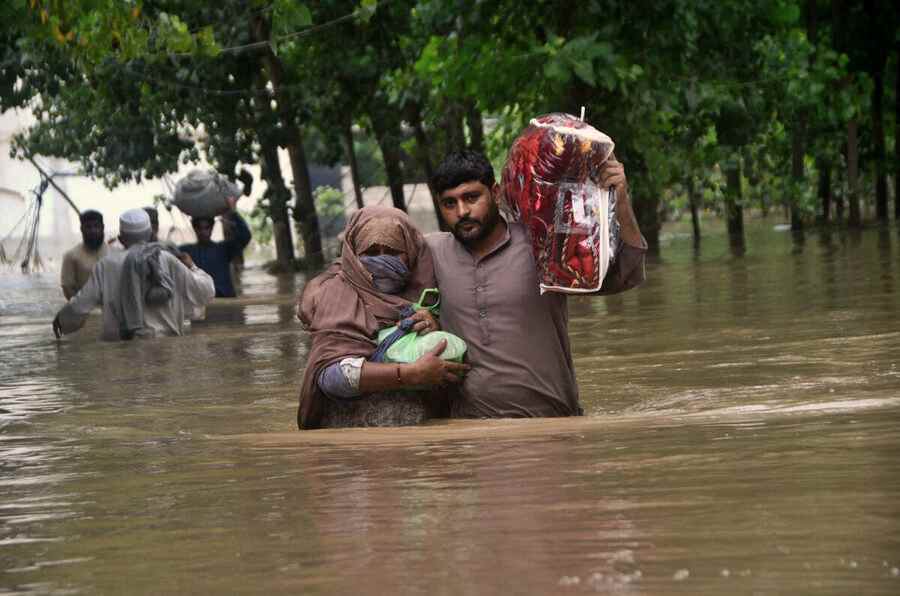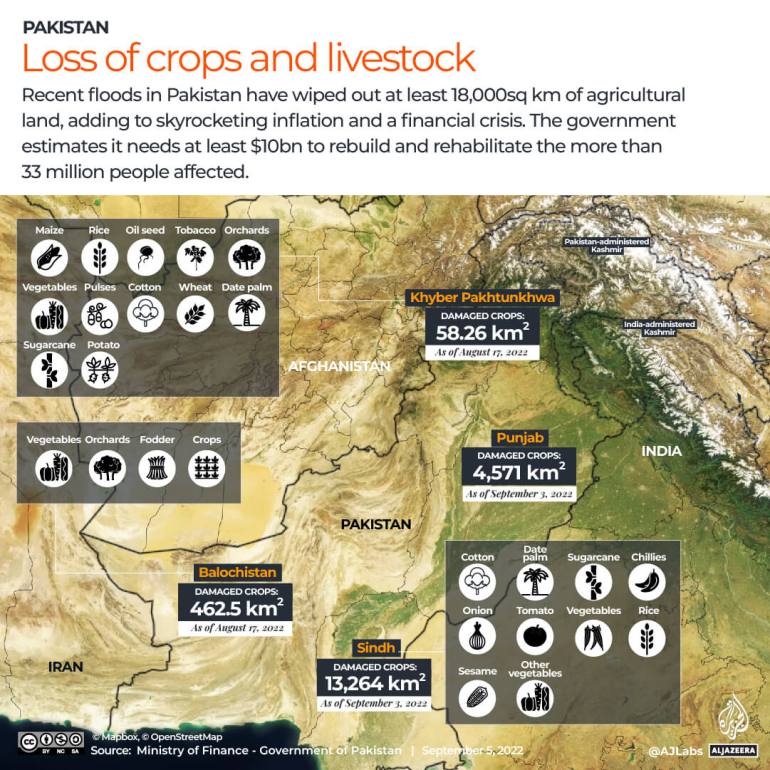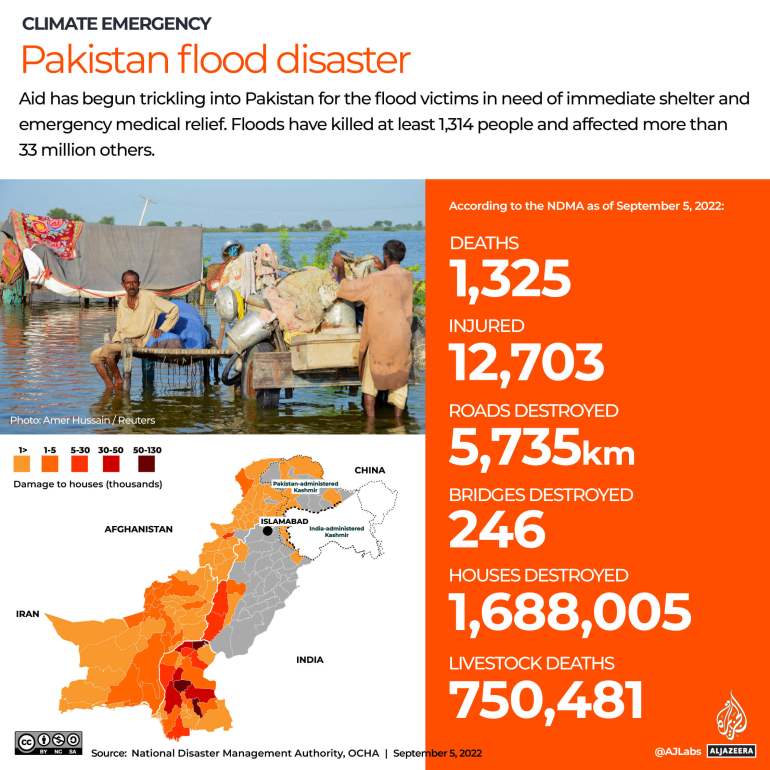Wed 07 September 2022:
The rain has destroyed vast hectares of crops, including cotton, a key source of employment and forex for the nation.
Tanveer Aziz Kingrani was planning to spend August preparing for his term examinations at the University of Sindh. Instead, the 23-year-old aspiring physicist has been camping out in a tent with 18 family members for the past week after his village was completely submerged in floods.
A resident of Haji Manik Khan village, 20km (12 miles) from Dadu city in Pakistan’s southern province of Sindh, Kingrani and his family are among the 33 million people who have been forced to leave their houses due to the unprecedented rains and floods that hit the region last month.
🇵🇰PAKISTAN: Starving flood victims face infectious diseases under open sky.
An alarming situation currently prevails in the flood-affected areas; hundreds & thousands of flood-affected people, live under the open sky, are grappling with hunger & disease, #PakistanFloods2022 pic.twitter.com/VX3E1nDknc
— INDEPENDENT PRESS (@IpIndependent) September 5, 2022
On the 12 hectares (30 acres) of farmland that Kingrani’s father owns, he sows rice, cotton, and wheat during the winter. But the rains have not only destroyed his standing crops of rice and cotton, the Kingranis are now worried about their wheat crop as well.
“There’s so much water that there is no chance of it receding or draining before the next three months, and that means we will miss out on the timeframe to sow the wheat crop,” says Aziz Kingrani, Tanveer’s father.
“I have no other source of income besides my land and my pension,” says Aziz, a retired professor. “I have no idea how I will feed 18 people with my meagre pension. I may just have to recall my son from his college to help me out.”
Some 800km (500 miles) northwest of Kingrani’s village, similar tales are unfolding in Balochistan, Pakistan’s most impoverished province that saw 500 percent more precipitation than the annual average in the month of August.
More than one-third of Pakistan is submerged in water and at least 33 million people are affected because of unprecedented flooding ⤵️#PakistanFloods2022 #PakistanFloods pic.twitter.com/y7ovbHhEWb
— INDEPENDENT PRESS (@IpIndependent) September 1, 2022
Abdul Bashir Jatoi, a farmer in Dera Allah Yar city, says his entire village, including 10 hectares (25 acres) of farmland, has been submerged. As have the roughly 800 hectares (2,000 acres) of arable land in the adjoining four to five villages.
“I had invested close to 500,000 [Pakistani] rupees [$2,240] for my rice crop, hoping to earn a profit of close to 1,500,000 [Pakistani] rupees [$6,720] but it was not to be. Now I am just waiting for God to send some help,” the 45-year-old farmer told Al Jazeera.
But beyond the human losses, the country’s economic managers have the most challenging task ahead as floods ravaged the country’s road and communication network, damaged an incalculable number of houses, and destroyed millions of hectares of crops.
Low forex, high inflation, devastated crops
The agriculture sector makes up nearly a fourth of Pakistan’s gross domestic product at 22.7 percent. Its massive destruction — including that of the cotton crop, a key source of revenue for the country — comes at a time when Pakistan has been struggling with fast-shrinking foreign exchange reserves and when it is already reeling under severe inflation, which touched 27.3 percent in August, a five-decade high
As per a UN Food and Agriculture Organization August 29 report, almost 80 percent of crops in Sindh, which produces roughly 30 percent of Pakistan’s total cotton output, were destroyed.
Close to 70 percent of Pakistan’s textile industry, an important source of employment and foreign exchange, uses the cotton produced in the country. Since nearly 35 percent of that is produced in Sindh province by farmers like Kingrani, the sector is girding itself for a shortage, said Abdul Rahim Nasir, chairman of All Pakistan Textile Mills Association, an industry body.
This, Nasir said, could set the country back significantly, especially with its dwindling foreign currency. “We often import over four million bales to meet our requirements. Due to the current shortage, we may end up having to import double that, at a potential cost of close to $3bn,” he said.
🇵🇰: Pakistan food security under threat as floods disrupt farming
Effect of extreme flooding on #Pakistani food security is becoming apparent: large swathes of farmland under water, crops and stockpiles washed away, homes and livelihoods wiped out.
#PakistanFloods2022 pic.twitter.com/ymZoxo3EKY— INDEPENDENT PRESS (@IpIndependent) September 1, 2022
Their calculations are based upon data compiled by the National Disaster Management Authority as well as its provincial off-shoots, the Provincial Disaster Management Authority, Younus said.
However, experts have warned that while the direct financial cost of the disaster in terms of lost bridges, buildings, road networks, crops and livestock can be determined, what the government will have to also prepare for is its spillover effect on the rest of the economy.
“What will be harder to determine right now is the broader economic loss, such as through decrease in economic activity, knock-on effects on cost of living. It will take months to determine these comprehensive losses,” said Shahrukh Wani, an economist at the Blavatnik School of Government, University of Oxford.
IMF conditions
For now, the more immediate challenge that Pakistan’s economic team will face is to fulfil the conditions of raising taxes and applying austerity measures as part of its agreement with the International Monetary Fund for its bailout package, which was approved last month for the cash-strapped country.
Wani, the Oxford economist, says the flood will make it terribly difficult for the government to reduce its trade deficit targets because while the country will need to import food to “compensate” for lost crops, the textile sector will find itself struggling due to a potential shortage of cotton crop.
While agreeing with the precarious state of affairs, Khalid Abdullah, cotton commissioner of Pakistan’s Ministry of National Food Security, said that the government is still “assessing exact figures of loss” and focusing more on “relief work”.
Satellite images show Pakistan flood as its ‘third’ under water
Rains in Pakistan that began in June have unleashed the worst flooding in more than a decade, washing away swathes of vital crops &damaging or destroying more than a million homes.#PakistanFloods #PakistanFlood pic.twitter.com/FCZZaNsnEm
— INDEPENDENT PRESS (@IpIndependent) August 30, 2022
There may be a slight respite in sight as flood damage was limited in Punjab province, one of the key agricultural areas, pointed out Muhammed Ali Talpur, another senior official at the Ministry of Food Security and vice president of the Pakistan Central Cotton Committee.
“Flood damage in Punjab was limited to only Rajanpur and Dera Ghazi Khan. Hopefully, they can give good results,” Talpur said.
But for the business community, the situation looks unsalvageable this year.
“More than 80 percent of Sindh’s crops are damaged. We have considerable damage in Punjab as well. Quality of surviving crops is not up to the standard either so we don’t know how much of it can be used,” he told Al Jazeera.
“I think a lot of cotton will be imported this year,” he said.

___________________________________________________________________________________________________________________________________________
FOLLOW INDEPENDENT PRESS:
TWITTER (CLICK HERE)
https://twitter.com/IpIndependent
FACEBOOK (CLICK HERE)
https://web.facebook.com/ipindependent
Think your friends would be interested? Share this story!







